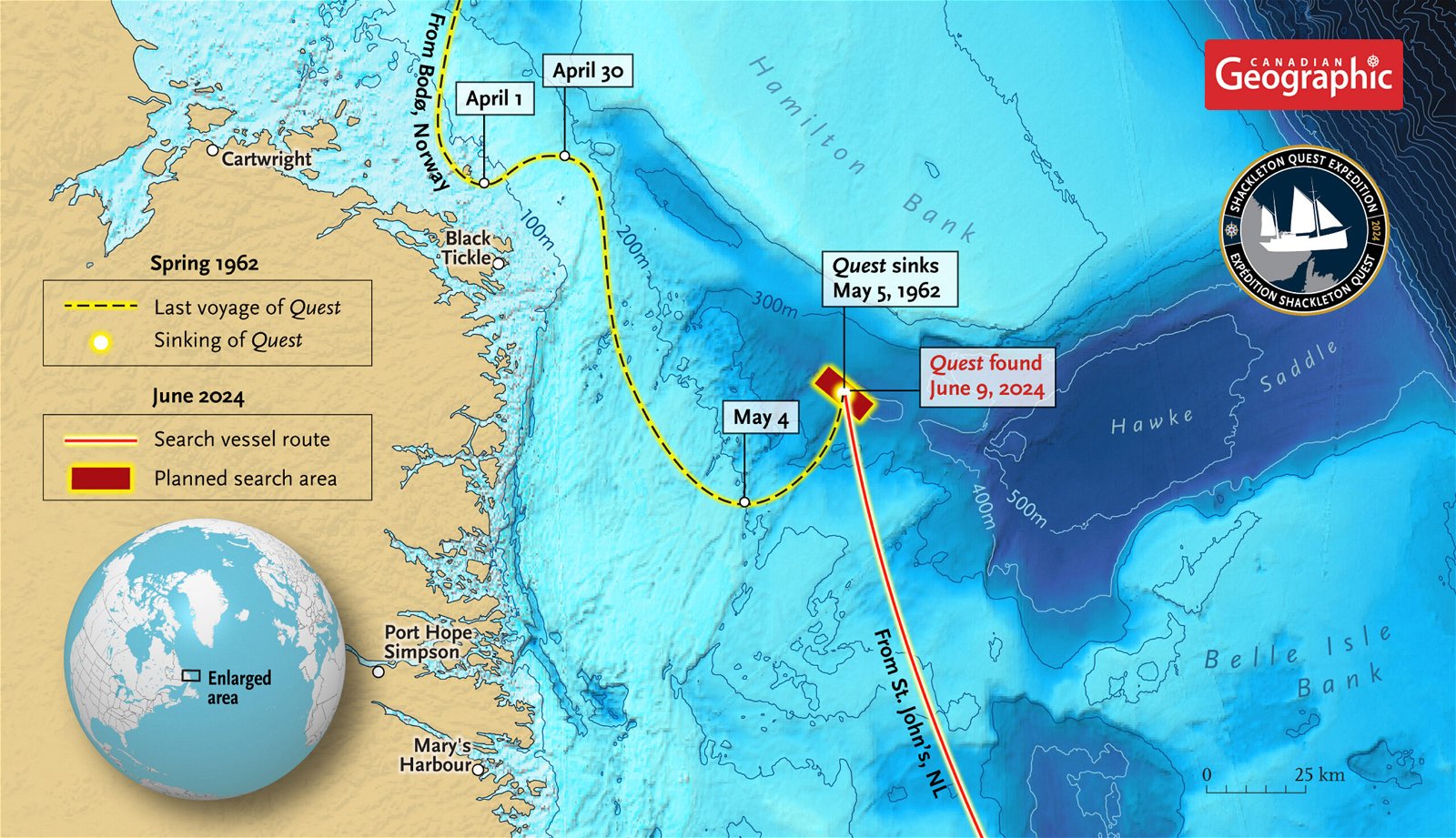The sunken wreckage of Quest, the sailing vessel used by famed British-Irish explorer Sir Ernest Shackleton on his final voyage, has now been discovered off the coast of Newfoundland, Canada.
Using sonar, a team headed by the Royal Canadian Geographical Society (RCGS) found the ship at 390m (or 1,280ft) below the surface of the Labrador Sea, a body of water between Newfoundland and Greenland. The ship appeared to be mostly intact, with only its main mast broken and leaning over the vessel’s port side.
Shackleton’s last voyage on Quest ended when he suffered a fatal heart attack aboard the ship on January 5, 1922, as the explorer and his team were headed to Antarctica. While Quest continued to sail, it eventually sunk in 1962 after Norwegian sealers using the vessel ran into a piece of thick sea ice, which pierced the ship’s hull. The crew survived the incident.


“Finding Quest is one of the final chapters in the extraordinary story of Sir Ernest Shackleton,” expedition leader John Geiger told Newsweek. “Shackleton was known for his courage and brilliance as a leader in times of crisis.”
Endurance: The Shackleton Enigma
Interestingly, a similar fate befell an earlier ship used by Shackleton, the renowned Endurance. This vessel was the one Shackleton and his 28 crew members were stranded on during the ill-fated 1914 expedition to Antarctica. Shackleton’s plan was to traverse the South Pole from the Weddell Sea to the Ross Sea. However, on January 19, 1915, the Endurance got stuck in the thick ice of the Weddell Sea. Over the next nine months, the ship was eventually crushed and sank beneath the ice.
Shackleton and his crew survived by camping on the ice away from Endurance. When the ice began to separate, the sailors hopped into smaller boats and sailed through treacherous conditions, later ending up at Elephant Island. Shackleton continued to make several journeys to get his men’s help as Elephant Island was uninhabited. Eventually, all crew members were rescued, and Shackleton was commended for his brave efforts. Several of the same crew signed up for Shackleton’s later expedition on the Quest.
Using Quest, Shackleton planned to explore the Arctic above Alaska. However, when the Canadian government withdrew its funding, Shackleton turned his ship southward back to Antarctica.
The Quest for Quest
Even after Shackleton’s death, Quest was used for many other explorations and rescue missions and even served in the Royal Canadian Navy during WWII.


To find the Quest wreckage, RCGS researchers began by looking at old newspaper clippings, shipping maps, and legal documents. However, the final position of Quest was transmitted in an old telegram from 1962: 53’10 N, 54’27 W.
Looking at the ice and weather patterns at that time, the RCGS team believed they had a potential wreckage site and used sonar devices to verify their find.
“I was thrilled, really excited to hear the news; I have relief and happiness and a huge admiration for the members of the team,” Alexandra Shackleton, Shackleton’s granddaughter, told BBC News. “For me, this represents the last discovery in the Shackleton story. It completes the circle.”
Currently, the actual coordinates of the Quest wreck are unavailable to the public, as the RCGS is planning a second visit to the wreck site for a more thorough investigation. Because the wreck is in a wildlife-protected area in the Labrador Sea, the RCGS team plans to avoid touching the wreck at all costs but instead wants to photograph Quest using an ROV (a remotely operated vehicle).
Adding to Shackleton’s Rich Legacy
Shackleton’s explorations not only gave further insights into Antarctica’s extreme ecosystems but also showcased his abilities as a leader.
“Shackleton will live forever as one of the greatest explorers of all time, not just because of what he achieved in exploration but for the way he did it, and the way he looked after his men,” said famed shipwreck hunter David Mearns, who led the recent Quest exploration.
“His story is timeless,” Mearns told the BBC, “and will be told again and again; and I’m just one of many disciples who’ll keep telling it for as long as I can.”
Kenna Hughes-Castleberry is the Science Communicator at JILA (a world-leading physics research institute) and a science writer at The Debrief. Follow and connect with her on X or contact her via email at kenna@thedebrief.org
